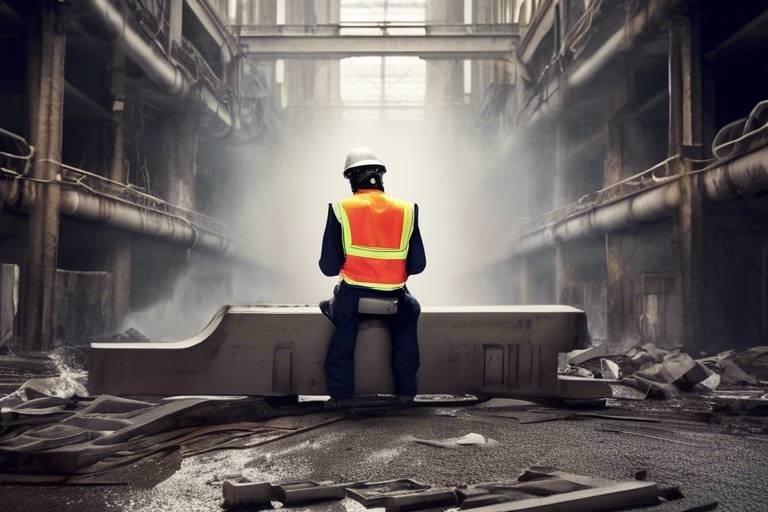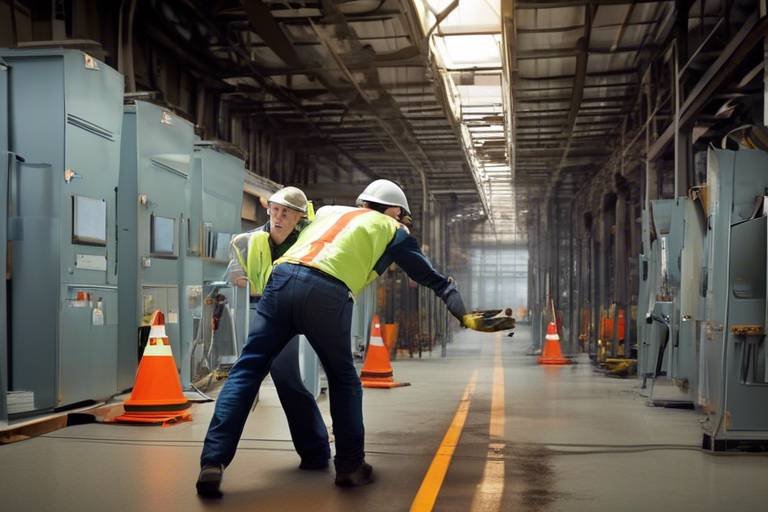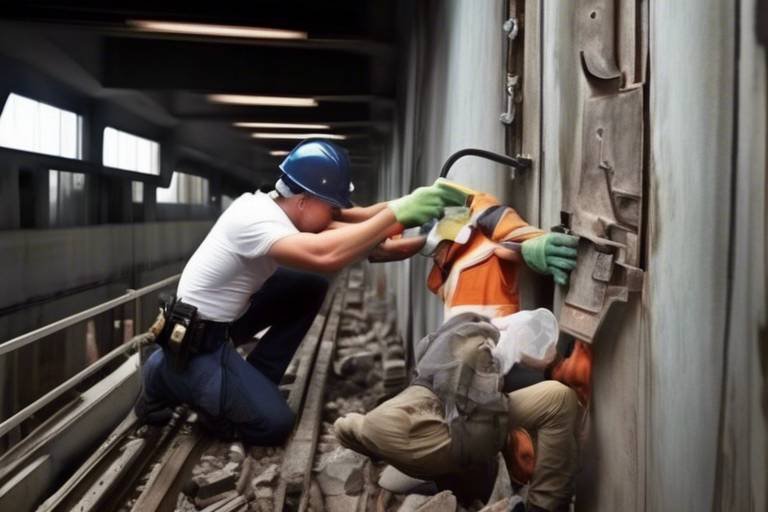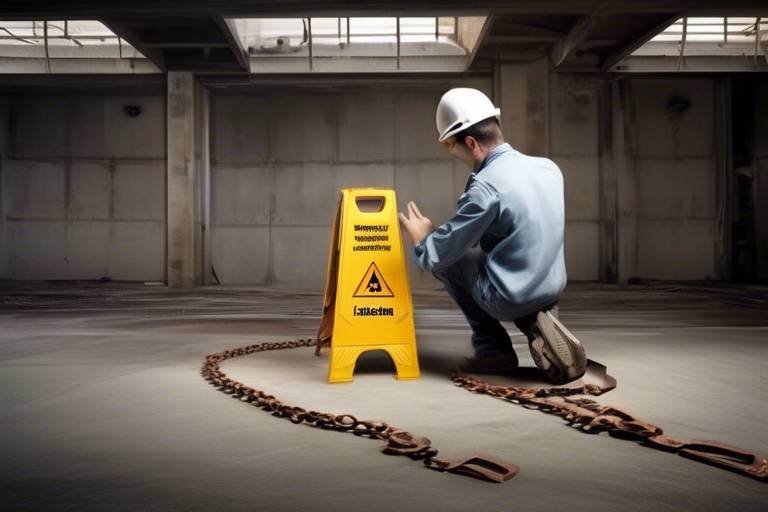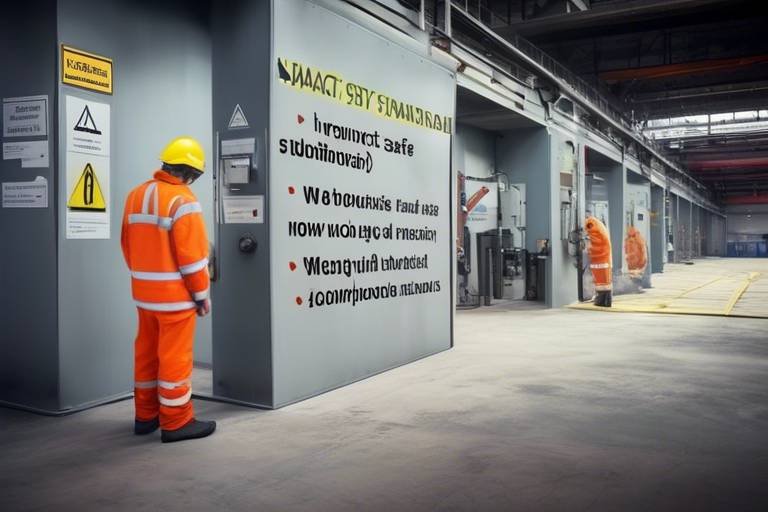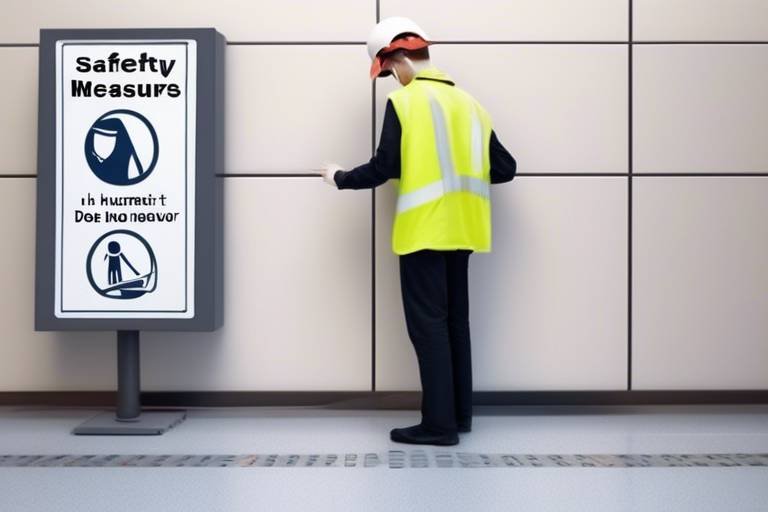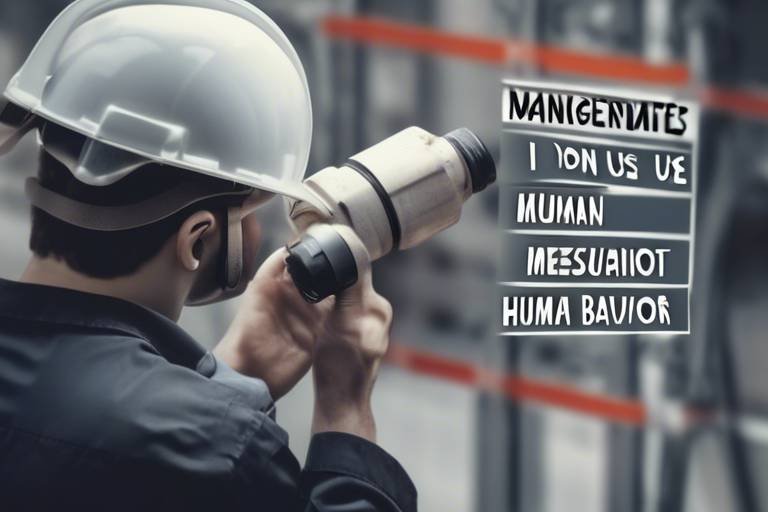Navigating Safety Measures With the Help of Human Behavior
In today's fast-paced world, the intersection of human behavior and safety measures is more critical than ever. As we navigate various environments, from workplaces to public spaces, understanding the psychological factors that influence our actions can significantly enhance the effectiveness of safety protocols. Think about it: how often do we overlook safety guidelines because they feel cumbersome or irrelevant? By delving into the intricacies of human behavior, we can craft safety measures that not only protect but also resonate with individuals on a personal level. This approach transforms safety from a mere obligation into a shared value, fostering a culture where everyone feels responsible for their well-being and that of others.
Understanding the psychological factors that influence behavior can significantly impact safety measures, helping organizations create environments that prioritize safety through awareness and proactive measures. For instance, when individuals feel a personal connection to safety protocols, they are more likely to adhere to them. This connection can be cultivated through training programs that emphasize the importance of safety in everyday life. It’s like teaching someone to drive; you don’t just tell them to follow the rules; you help them understand why those rules exist and how they can protect themselves and others. By tapping into the psychology of safety, we can create a more engaged workforce that values safety as a fundamental aspect of their daily routine.
Implementing behavioral safety programs can foster a culture of safety by encouraging individuals to take responsibility for their actions and the safety of their peers, ultimately reducing accidents and injuries. These programs often focus on changing behaviors rather than simply enforcing rules. Imagine a workplace where employees actively look out for one another, much like a team in a high-stakes game. Each player understands their role in ensuring the team's success and safety. By promoting such a culture, organizations can significantly reduce the number of incidents and cultivate a sense of community and shared responsibility.
Effective training programs that focus on human behavior can enhance safety awareness, equipping individuals with the knowledge and skills needed to recognize and mitigate potential hazards in their environment. These training sessions should not be dull lectures but rather interactive experiences where participants can engage in discussions and role-playing scenarios. By simulating real-life situations, employees can better understand the implications of their actions and learn to respond appropriately in emergencies. This hands-on approach not only makes the training more enjoyable but also reinforces the importance of safety in a practical, memorable way.
Engaging employees in safety discussions and initiatives can boost morale and commitment to safety practices, leading to a more proactive approach to risk management. When employees feel that their voices are heard and valued, they are more likely to contribute positively to the safety culture. Consider holding regular safety meetings where team members can share their experiences and suggestions. This not only fosters a sense of community but also empowers individuals to take ownership of their safety and that of their colleagues.
Establishing feedback mechanisms allows employees to voice concerns and suggest improvements, fostering a collaborative environment where safety is a shared responsibility. This could be as simple as a suggestion box or as sophisticated as an online platform where employees can submit their ideas anonymously. By actively seeking feedback, organizations demonstrate that they value employee input, which can lead to innovative safety solutions and a more engaged workforce.
Building a strong safety culture involves integrating safety into everyday practices, encouraging open communication, and recognizing safe behaviors to reinforce the importance of safety in the workplace. It’s essential to celebrate successes, no matter how small, as this reinforces the desired behaviors. For example, consider implementing a recognition program where employees are acknowledged for their commitment to safety. This not only motivates individuals but also sets a standard for others to follow.
Examining the role of human error in safety incidents helps organizations identify areas for improvement, enabling them to design systems that minimize the likelihood of mistakes and enhance overall safety. Understanding that errors are often a result of systemic issues rather than individual failings is crucial. It’s like a puzzle; if one piece is missing or misplaced, the entire picture can be distorted. By analyzing incidents and understanding the underlying factors, organizations can create a more robust safety framework that accommodates human behavior.
By analyzing common human errors, organizations can develop targeted training and interventions that address specific behaviors contributing to safety risks. This involves looking at the data from past incidents and identifying patterns. For instance, if a particular task frequently leads to accidents, it may be worth revisiting the training provided or the tools used. This proactive approach not only reduces risks but also empowers employees to take an active role in their safety.
Creating systems that account for human error involves implementing safeguards and redundancies that reduce the potential impact of mistakes, ensuring a safer environment for all. This could include features like automatic shut-off mechanisms in machinery or clear signage that reminds employees of safety protocols. By designing systems with human behavior in mind, organizations can create environments that are not only safer but also more efficient.
- What are behavioral safety programs? Behavioral safety programs focus on changing individual behaviors to improve safety outcomes in the workplace.
- How can I engage employees in safety initiatives? Regular safety meetings, feedback mechanisms, and recognition programs can encourage employee involvement.
- What role does human error play in safety? Human error can often be a symptom of systemic issues, and addressing these can improve overall safety.

The Psychology of Safety
Understanding the psychological factors that influence behavior can significantly impact safety measures, helping organizations create environments that prioritize safety through awareness and proactive measures. At its core, the psychology of safety revolves around how individuals perceive risks and make decisions based on their experiences, emotions, and social influences. For instance, have you ever wondered why some people seem to take risks without a second thought, while others are overly cautious? This discrepancy often stems from deep-seated psychological factors that shape our understanding of safety.
One of the key elements in this psychological framework is the concept of risk perception. Individuals assess risks based on various factors, including personal experiences, cultural background, and even media influences. When organizations grasp these perceptions, they can tailor their safety protocols to resonate better with their employees. For example, if workers perceive a task as low-risk, they may not adhere to safety measures as strictly. Thus, educating them on the actual risks involved can bridge this gap and enhance compliance.
Moreover, motivation plays a crucial role in safety behavior. People are more likely to engage in safe practices when they feel a personal stake in the outcome. This can be fostered by creating a sense of ownership over safety measures. When employees believe that their actions directly contribute to a safer workplace, they are more inclined to follow protocols diligently. Organizations can encourage this ownership by involving employees in the development and implementation of safety measures, making them feel valued and responsible.
Another significant psychological aspect is social influence. Human beings are inherently social creatures, and their behaviors are often shaped by the actions and attitudes of those around them. If a workplace has a culture that prioritizes safety, individuals are more likely to adopt safe behaviors. Conversely, if they observe peers engaging in risky behavior without consequences, they may feel compelled to follow suit. Therefore, fostering a positive safety culture is essential in ensuring that safety becomes a collective priority.
To effectively integrate these psychological insights into safety measures, organizations can utilize various strategies. Here’s a quick look at some approaches:
- Training Programs: Implement training that emphasizes the psychological aspects of safety, helping employees understand their motivations and perceptions.
- Open Communication: Encourage open dialogue about safety concerns, allowing employees to express their thoughts without fear of judgment.
- Peer Recognition: Establish recognition programs that reward safe behaviors, reinforcing positive actions within the workforce.
Ultimately, the psychology of safety is about more than just protocols and procedures; it’s about understanding the human element that drives safety behavior. By recognizing the psychological factors at play, organizations can create a more robust safety culture that not only protects employees but also enhances overall productivity and morale.

Behavioral Safety Programs
Implementing is not just a trend; it's a crucial strategy for organizations aiming to cultivate a culture of safety. These programs focus on understanding how human behavior affects safety in the workplace. When employees recognize their role in maintaining safety, they become more engaged and responsible, leading to a significant reduction in accidents and injuries. But how exactly do these programs work, and why are they so effective?
At the heart of behavioral safety programs is the idea that safety is a shared responsibility. Instead of placing the onus solely on management, these initiatives encourage every individual to take ownership of their actions. This can be likened to a team sport where every player must perform their role for the team to succeed. In this context, safety becomes a collective goal, and everyone plays a part in achieving it.
One of the key components of these programs is training and awareness. Organizations that invest in comprehensive training programs focused on human behavior equip their employees with the necessary skills to identify and mitigate potential hazards. This training often includes real-life scenarios that resonate with workers, making them more likely to remember and apply what they've learned. Imagine walking into a room filled with potential hazards; without the right training, you might overlook something critical. But with effective training, you become a vigilant guardian of your environment.
Moreover, engaging employees in safety discussions is vital. When employees feel their voices are heard, it boosts morale and fosters a stronger commitment to safety practices. Regular safety meetings can serve as a platform for open dialogue, where team members can share experiences, concerns, and suggestions. Think of it as a safety brainstorming session—everyone contributes, and together, they can devise innovative solutions to potential risks.
Another essential aspect of behavioral safety programs is the establishment of feedback mechanisms. These systems allow employees to report unsafe conditions or behaviors without fear of retribution. By creating a culture where feedback is welcomed, organizations can identify areas for improvement and make necessary adjustments. For instance, if an employee notices a recurring safety issue, they should feel empowered to bring it to the attention of their supervisors. This collaborative approach not only enhances safety but also builds trust within the team.
To illustrate the effectiveness of behavioral safety programs, consider the following table that outlines some common elements and their impacts:
| Program Element | Description | Impact |
|---|---|---|
| Training | Focuses on human behavior and hazard recognition. | Increased awareness and reduced incidents. |
| Engagement | Involves employees in safety discussions. | Boosted morale and commitment. |
| Feedback | Encourages reporting of unsafe conditions. | Improved safety measures and trust. |
In conclusion, behavioral safety programs are essential for fostering a proactive safety culture within organizations. By focusing on human behavior, implementing effective training, engaging employees, and establishing feedback mechanisms, companies can significantly enhance their safety protocols. The result? A safer workplace where everyone contributes to the well-being of their colleagues.

Training and Awareness
Effective training programs that focus on human behavior can significantly enhance safety awareness in any organization. Imagine a workplace where every individual not only understands the safety protocols but also feels empowered to act on them. This is the kind of environment that comprehensive training can cultivate. By integrating psychological principles into training, organizations can equip employees with the necessary tools to recognize potential hazards and respond appropriately. It's not just about following rules; it's about fostering a mindset that prioritizes safety at every level.
One of the keys to successful training is making it relatable and engaging. Traditional training sessions can sometimes feel like a chore, leading to disengagement. However, by employing interactive methods, such as role-playing scenarios or simulation exercises, organizations can create immersive experiences that resonate with employees. For instance, instead of just lecturing on the importance of wearing safety gear, a training session could involve a hands-on activity where employees must navigate a simulated hazardous environment while correctly using the gear. This not only reinforces the importance of safety measures but also makes the learning process enjoyable.
Moreover, ongoing training is crucial. Safety isn't a one-time lesson; it's a continuous journey. Organizations should implement regular refresher courses and updates on new safety protocols or technologies. This could be in the form of monthly workshops or quarterly safety drills, designed to keep safety at the forefront of everyone’s mind. The more frequently employees engage with safety training, the more likely they are to internalize these practices and apply them in real-world situations.
To further enhance training effectiveness, organizations can incorporate feedback mechanisms where employees can share their experiences and suggestions. This creates a two-way communication channel that not only empowers employees but also allows management to refine training programs based on real-world insights. For example, if multiple employees express difficulty in understanding a particular safety procedure, management can revise the training materials to make them clearer and more accessible.
In conclusion, investing in training and awareness is not just about compliance; it’s about cultivating a culture where safety is a shared responsibility. When employees feel informed and involved, they are more likely to take proactive steps in ensuring their own safety and that of their colleagues. This cultural shift can lead to a significant reduction in accidents and injuries, ultimately creating a safer workplace for everyone.
- What is the importance of training in safety measures? Training is essential as it empowers employees with knowledge and skills to recognize and mitigate hazards.
- How can organizations make training more engaging? By using interactive methods such as simulations and role-playing to create immersive learning experiences.
- Why is ongoing training necessary? Safety protocols can evolve, and regular training ensures that employees stay updated and engaged with the latest practices.
- What role does feedback play in safety training? Feedback allows organizations to refine training programs based on employee experiences, making them more effective.

Engaging Employees
Engaging employees in safety discussions is not just a checkbox exercise; it’s a vital component in building a robust safety culture. When employees feel they have a voice in safety initiatives, they are more likely to take ownership of their actions and contribute to a safer workplace. Think of it like a team sport—everyone has a role to play, and when each player is engaged, the team performs better. So, how do we create this engagement? It starts with open communication. Encouraging employees to share their thoughts and experiences regarding safety can lead to invaluable insights that management might overlook.
Moreover, involving employees in safety training sessions can make a world of difference. Instead of a one-way lecture, why not turn these sessions into interactive workshops? This not only keeps the energy levels high but also allows employees to learn from each other. In such an environment, safety becomes a collective responsibility rather than just a set of rules mandated by management. For instance, when employees share their near-miss experiences, it fosters a sense of community and shared learning, making everyone more vigilant.
Another effective way to engage employees is through safety committees. These committees can consist of representatives from various departments, ensuring that diverse perspectives are considered. Regular meetings can provide a platform for discussing safety concerns and brainstorming solutions. This not only empowers employees but also enhances their commitment to safety practices. After all, when employees are part of the decision-making process, they are more likely to follow through on safety protocols.
Additionally, recognizing and rewarding safe behavior can significantly boost morale. When employees see that their efforts to maintain a safe environment are acknowledged, it reinforces their commitment. Consider implementing a recognition program where employees can be nominated for awards based on their safety contributions. Such initiatives not only motivate individuals but also create a ripple effect, encouraging others to prioritize safety as well.
Lastly, leveraging technology can also play a crucial role in engaging employees. Mobile apps and online platforms can provide real-time safety updates and allow employees to report hazards instantly. This immediacy can transform how safety is perceived in the workplace, making it a continuous conversation rather than a periodic topic. By utilizing technology, organizations can keep safety at the forefront of employees' minds, ensuring that everyone remains vigilant and proactive.
In conclusion, engaging employees in safety practices is more than just a strategy; it’s about creating a culture where everyone feels responsible for their safety and that of their peers. By fostering open communication, involving employees in training and decision-making, recognizing safe behavior, and leveraging technology, organizations can transform safety from a set of rules into a shared commitment. After all, when safety becomes a collective endeavor, everyone wins.
- Why is employee engagement important for workplace safety?
Engaging employees fosters a sense of ownership and responsibility, leading to a more proactive approach to safety and a reduction in accidents. - How can organizations encourage employees to participate in safety initiatives?
Organizations can encourage participation by creating open communication channels, involving employees in training, and recognizing their contributions to safety efforts. - What role does technology play in enhancing employee engagement in safety?
Technology can facilitate real-time communication, hazard reporting, and ongoing training, making safety a continuous conversation in the workplace.

Feedback Mechanisms
Feedback mechanisms are essential components of any robust safety program. They serve as the **bridge** between management and employees, allowing for open communication about safety concerns and practices. When employees feel that their voices are heard, it not only boosts morale but also enhances the overall safety culture within an organization. Imagine a workplace where everyone is actively participating in safety discussions; it’s like a well-oiled machine, each part working harmoniously towards a common goal: safety.
One of the most effective ways to implement feedback mechanisms is through regular safety meetings. These gatherings can serve as a platform for employees to share their experiences, report hazards, and suggest improvements. By fostering an environment where employees feel comfortable voicing their concerns, organizations can identify potential safety risks before they escalate into serious incidents. Additionally, utilizing anonymous surveys can provide an avenue for employees who may be hesitant to speak up in public settings. This anonymity can encourage more honest and candid feedback.
Moreover, organizations can benefit from establishing a formalized feedback system that tracks and addresses employee concerns. For instance, a simple table can be implemented to categorize feedback, track responses, and monitor the resolution of issues. Here's an example of how such a table might look:
| Feedback Category | Employee Name | Date Submitted | Status | Resolution Date |
|---|---|---|---|---|
| Hazard Reporting | John Doe | 2023-10-01 | Under Review | N/A |
| Safety Training | Jane Smith | 2023-10-02 | Resolved | 2023-10-05 |
This table not only provides clarity but also demonstrates that the organization values employee input and is committed to addressing safety concerns. Additionally, **recognizing** employees who contribute valuable feedback can further motivate others to participate in the process. Acknowledgment can take various forms, such as shout-outs in team meetings or even small rewards, reinforcing the idea that safety is a shared responsibility.
In conclusion, effective feedback mechanisms are not just about collecting information; they are about fostering a culture of safety where every employee feels empowered to contribute. By creating a system that values feedback, organizations can continuously improve their safety protocols and ensure a safer working environment for everyone. So, why not start today? Establish those channels for feedback, and watch as your workplace transforms into a safer, more collaborative space.
- What are feedback mechanisms in safety programs?
Feedback mechanisms are systems put in place to allow employees to communicate their safety concerns and suggestions to management, fostering a culture of safety. - How can I encourage employees to provide feedback?
Creating a safe environment for open discussion, utilizing anonymous surveys, and recognizing contributions can encourage employees to share their feedback. - What should be included in a feedback system?
A feedback system should include categories for feedback, a method for tracking submissions, and a process for addressing concerns.

Creating a Safety Culture
Building a strong safety culture is like nurturing a garden; it requires consistent attention, care, and the right environment to flourish. Just as plants need sunlight, water, and nutrients, a safety culture thrives on open communication, shared values, and collective commitment. When organizations prioritize safety as a core value, they create an atmosphere where employees feel empowered to speak up about hazards and actively participate in safety initiatives.
One of the key components of fostering this culture is integrating safety into everyday practices. Imagine walking into a workplace where safety is as instinctive as buckling your seatbelt in a car. This can be achieved by regularly incorporating safety discussions into team meetings, making safety a part of the daily routine. For instance, starting meetings with a brief safety moment can remind everyone of the importance of vigilance and awareness. This simple act not only sets the tone but also reinforces that safety is everyone's responsibility.
Moreover, recognizing and rewarding safe behaviors can act as a powerful motivator. When employees see that their commitment to safety is acknowledged, it encourages them to continue prioritizing it. This can be done through various means such as safety awards, shout-outs in company newsletters, or even simple verbal recognition during meetings. By celebrating safe practices, organizations can create a positive feedback loop that promotes a culture of safety.
Additionally, open communication is vital in creating a safety culture. Employees should feel comfortable discussing their concerns without fear of retribution. Establishing regular forums for feedback, such as safety committees or suggestion boxes, can facilitate this dialogue. When employees know their voices matter, they are more likely to engage in safety practices actively. For example, if a worker notices a potential hazard and feels encouraged to report it, the entire workplace benefits from their vigilance.
To further enhance this culture, organizations can implement training programs that emphasize the importance of safety in a relatable manner. These programs should not only focus on rules and regulations but also on the real-life implications of unsafe behaviors. By using relatable scenarios and engaging storytelling, employees can better understand the impact of their actions on their own safety and that of their colleagues.
In conclusion, creating a safety culture is not a one-time effort; it is an ongoing journey. By integrating safety into daily practices, recognizing safe behaviors, fostering open communication, and providing engaging training, organizations can cultivate an environment where safety is ingrained in the fabric of the workplace. Just like a well-tended garden, a strong safety culture will not only survive but thrive, yielding a healthier and safer workplace for all.
- What is a safety culture? A safety culture refers to the shared values, beliefs, and practices regarding safety within an organization, emphasizing the importance of safety in everyday operations.
- How can I contribute to a safety culture? You can contribute by being proactive in safety discussions, reporting hazards, and recognizing safe behaviors among your peers.
- Why is open communication important in safety culture? Open communication allows employees to voice their concerns and suggestions, fostering a collaborative environment that prioritizes safety.
- What are some ways to recognize safe behaviors? Recognition can come in many forms, such as awards, verbal praise, or highlighting safe practices in company communications.

Human Error and Safety
When it comes to safety, one of the most critical factors to consider is human error. It's a term that often gets thrown around, but what does it really mean in the context of safety? Essentially, human error refers to mistakes made by individuals that can lead to accidents or unsafe situations. Understanding this concept is vital for organizations aiming to enhance their safety protocols. After all, no matter how robust your safety measures are, if human error is not addressed, the risk of incidents remains. So, how do we tackle this issue? By examining the role of human error, organizations can identify areas for improvement and devise strategies that minimize the likelihood of mistakes.
One effective way to get started is by identifying common errors that occur in the workplace. These can range from simple oversights, such as forgetting to wear personal protective equipment, to more complex issues like miscommunication during a critical task. By analyzing these frequent errors, organizations can develop targeted training programs aimed at addressing specific behaviors that contribute to safety risks. For instance, if data shows that employees often overlook safety checks, training can focus on reminding them of the importance of these checks and how to implement them effectively.
Moreover, it’s essential to create systems that are error-tolerant. This means designing processes that account for the possibility of human mistakes. For example, implementing safeguards and redundancies can significantly reduce the potential impact of errors. Imagine a safety net that catches you when you stumble; that’s the kind of system organizations should aim to establish. By doing this, they not only enhance safety but also foster a culture of accountability where employees feel supported rather than scrutinized for their mistakes.
To illustrate this further, consider the following table that outlines common human errors and potential strategies to mitigate them:
| Common Human Error | Potential Mitigation Strategy |
|---|---|
| Failure to follow safety protocols | Regular training and reminders |
| Miscommunication during tasks | Clear communication channels and checklists |
| Inattention to detail | Implementing a buddy system for critical tasks |
In conclusion, recognizing the role of human error in safety incidents is not just about pointing fingers but rather about fostering an environment of learning and improvement. By actively identifying common errors and designing error-tolerant systems, organizations can significantly enhance their safety measures. This proactive approach not only protects employees but also builds a culture of safety where everyone feels empowered to contribute to a safer workplace.
- What is human error in the context of safety? Human error refers to mistakes made by individuals that can lead to unsafe situations or accidents.
- How can organizations identify common human errors? By analyzing past incidents and gathering feedback from employees about their experiences and observations.
- What are error-tolerant systems? These are systems designed to minimize the impact of human mistakes through safeguards and redundancies.

Identifying Common Errors
When it comes to safety in any environment, understanding and identifying common human errors is crucial. After all, mistakes are a part of being human, but recognizing these errors can help organizations develop effective strategies to mitigate risks. Think of it like a game of chess; if you can anticipate your opponent's moves, you can better prepare your defense. In the context of safety, this means being aware of the pitfalls that often lead to accidents or incidents.
One of the most prevalent types of errors is perceptual errors, where individuals misinterpret their environment or fail to notice hazards. For instance, an employee might overlook a spill on the floor during a busy shift, leading to a slip and fall incident. Similarly, decision-making errors can occur when someone makes a poor judgment call, perhaps due to stress or time pressure. Imagine a worker rushing to meet a deadline; in their haste, they might skip essential safety protocols, thinking they can save time. However, this can lead to dire consequences.
Another category is communication errors. These happen when information is not conveyed clearly or is misunderstood. For example, if a supervisor fails to adequately explain a new safety procedure, it could lead to confusion among employees, increasing the risk of accidents. In fact, studies show that effective communication can significantly reduce the incidence of workplace injuries. To illustrate this, consider the following table that highlights some common errors and their potential impacts:
| Error Type | Description | Potential Impact |
|---|---|---|
| Perceptual Errors | Misinterpretation of hazards | Increased accidents due to unnoticed dangers |
| Decision-Making Errors | Poor judgment under pressure | Neglect of safety protocols leading to incidents |
| Communication Errors | Misunderstanding of safety procedures | Confusion among staff, resulting in unsafe actions |
To effectively address these errors, organizations should implement a systematic approach to identify and analyze them. Regular training and awareness sessions can help employees recognize these common pitfalls, encouraging them to be more vigilant. Moreover, fostering an environment where employees feel comfortable reporting errors without fear of reprimand can lead to valuable insights. It's like having a safety net; when people know they can speak up, they contribute to a culture of safety.
In conclusion, identifying common errors is not just about pointing fingers; it's about creating a safer workplace for everyone. By understanding the types of errors that frequently occur, organizations can tailor their training and safety measures to address these specific issues. This proactive approach not only enhances safety but also cultivates a culture where everyone is invested in maintaining a safe environment.
- What are common human errors that can impact safety?
Common errors include perceptual errors, decision-making errors, and communication errors, all of which can lead to accidents if not addressed. - How can organizations reduce human errors?
By implementing regular training, fostering open communication, and creating a supportive environment for reporting errors. - Why is it important to identify these errors?
Identifying errors helps organizations develop targeted interventions, ultimately enhancing safety and preventing incidents.

Designing Error-Tolerant Systems
When it comes to safety, one of the most critical aspects is recognizing that human error is inevitable. No matter how skilled or trained an individual might be, mistakes can happen. This is where the concept of error-tolerant systems comes into play. Designing systems that account for human fallibility not only enhances safety but also fosters a culture of trust and accountability within organizations. Imagine a safety net that catches you before you hit the ground; that’s essentially what error-tolerant systems aim to do.
To create these systems, organizations must first understand the common types of errors that occur in their specific environments. For instance, in a manufacturing setting, errors might arise from equipment malfunctions or miscommunication among team members. By identifying these potential pitfalls, companies can implement strategies that mitigate their impact. This could involve introducing redundancies—essentially backup systems that kick in when the primary system fails. Think of it like having a spare tire in your car; it’s not just about having a functional vehicle, but also ensuring you’re prepared for the unexpected.
Moreover, involves creating user-friendly interfaces and processes that are intuitive and easy to navigate. When systems are complex and convoluted, the likelihood of errors increases. Therefore, involving end-users in the design process is crucial. This collaboration not only helps in crafting a more effective system but also makes employees feel valued and heard. After all, who knows the challenges of a job better than the people doing it every day?
Another key aspect is the implementation of safeguards. These can include alerts and warnings that notify users of potential errors before they escalate into serious issues. For example, in an aviation context, pilots are trained to follow checklists that serve as a safeguard against forgetfulness. Similarly, organizations can develop checklists or digital prompts that remind employees of critical safety procedures. This proactive approach can significantly reduce the margin for error.
Finally, it’s important for organizations to continuously evaluate and improve their error-tolerant systems. This involves collecting data on incidents and near misses, analyzing them, and making necessary adjustments. By treating safety as a dynamic process rather than a static one, organizations can stay ahead of potential risks and foster a culture of continuous improvement. In essence, just as a gardener tends to their plants to ensure they thrive, organizations must nurture their safety systems to promote a flourishing workplace.
- What are error-tolerant systems?
Error-tolerant systems are designed to minimize the impact of human errors by incorporating safeguards, redundancies, and user-friendly processes.
- Why is it important to design for human error?
Understanding that human error is inevitable allows organizations to create safer environments, reducing the likelihood of accidents and improving overall safety culture.
- How can organizations identify common errors?
Organizations can analyze incident reports, conduct employee surveys, and observe workflows to identify patterns and common mistakes.
- What role does employee involvement play in designing error-tolerant systems?
Involving employees in the design process ensures that the systems are user-friendly and effectively address the real challenges they face, leading to better outcomes.
Frequently Asked Questions
- What is the importance of understanding human behavior in safety measures?
Understanding human behavior is crucial because it helps organizations tailor safety measures that resonate with individuals. When safety protocols consider psychological factors, they become more effective. It’s like tuning a musical instrument; when everything is in harmony, the result is a safer and more aware environment.
- How can behavioral safety programs improve workplace safety?
Behavioral safety programs empower employees by encouraging them to take ownership of their actions and the safety of their peers. This proactive approach not only reduces accidents but also fosters a sense of community. Think of it like a team sport where everyone plays their part to win—safety becomes a shared goal.
- What role does training play in enhancing safety awareness?
Effective training is the backbone of safety awareness. It equips individuals with the necessary knowledge and skills to identify and mitigate hazards. Imagine being given a map before a treasure hunt; without it, you might miss hidden dangers that could lead to accidents.
- Why is employee engagement important in safety initiatives?
Engaging employees in safety discussions boosts morale and commitment. When workers feel involved, they're more likely to adhere to safety practices. It’s like inviting everyone to the table for a potluck dinner; when everyone contributes, the outcome is richer and more satisfying.
- How can feedback mechanisms enhance safety practices?
Feedback mechanisms allow employees to voice concerns and suggest improvements, creating a collaborative environment. This open line of communication is essential for fostering a culture where safety is everyone’s responsibility. It’s similar to having a suggestion box at a restaurant; feedback helps improve the overall experience.
- What constitutes a strong safety culture?
A strong safety culture integrates safety into everyday practices, promotes open communication, and recognizes safe behaviors. It’s like building a strong foundation for a house; without it, everything else is at risk of collapsing.
- How does human error impact safety incidents?
Human error is often a significant factor in safety incidents. By examining these errors, organizations can identify areas for improvement and design systems that minimize mistakes. Think of it like a game of chess; understanding your opponent's moves can help you strategize better and avoid pitfalls.
- What are common human errors that affect safety?
Common human errors include lapses in attention, poor decision-making, and miscommunication. By analyzing these behaviors, organizations can implement targeted training to address specific risks. It’s like diagnosing a cold; knowing the symptoms helps in finding the right remedy.
- How can organizations create error-tolerant systems?
Creating error-tolerant systems involves implementing safeguards and redundancies that reduce the potential impact of mistakes. This proactive design ensures that even if errors occur, the consequences are minimized. It’s akin to having a safety net while performing acrobatics; it provides a cushion when things go wrong.


